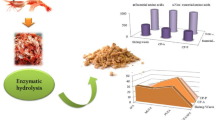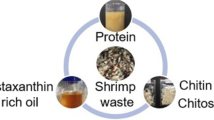Abstract
The present study was to investigate efficient extraction conditions of astaxanthin from shrimp wastes for utilizing it as a functional food additive. In order to enhance the stability of pigments, proteolytic enzymes were applied to extract astaxanthin as carotenoprotein. Also, various conditions such as acid ensilaging of samples, using EDTA solution and adding various enzymes were examined to optimize extraction processing. After extraction, all of the extracts were partitioned in a separate funnel and each astaxanthin content was analyzed by using UV/VIS spectrophotometer. Carotenoprotein was effectively extracted from non-acid ensilaged shrimp wastes by using EDTA medium and a proteolytic enzyme. In that case, the reddish top layer showed 91.9% of recovery and the blackish bottom layer did 2.3% and its separation ratio was about 0.2 (v/v); therefore concentration and purification of reddish top layer were more desirable than those of whole extract.
Similar content being viewed by others
References
Simpson, K. L., C. O. Chichester, and T. Katayama (1981) Carotenoids in fish feeds. pp. 463–538. In:Carotenoids as colorants and vitamin A precursors (J. C. Bauernfeind, ed.). Academic Press New York, NY, U.S.A.
Hata, M. and M. Hata (1972) Carotenoid pigments in goldfish. V. Conversion of zeaxanthin to astaxanthin.Nippon Suisan Gakkaishi. 38(4): 339–343.
Katayama, T., S. Kanji, and C. O. Chichester (1973) Biosynthesis of astaxanthin. VII. Carotenoids in sea bream,Chrysophrys major.Comp. Biochem. Physiol. 44B: 253–257.
Katayama, T., H. Tsuchiya, and C. O. Chichester (1971) Biosynthesis of astaxanthin. V. Interconversion of the algal carotenoids,Stigeoclonium species into fish carotenoids faney red carps.Kagoshima Daigaku Suisan Gakuba Kiyo. 20(1): 173–184.
Yamada, S., Y. Tanaka, M. Sameshima, and Y. Yan (1990) Pigmentation of prawn (Penaeus japonicus) with carotenoids. 1. Effect of dietary astaxanthin, 3-carotene and canthaxanthin on pigmentation.Aquaculture 87(3–4): 223–330.
Zagalsky, P. F. (1995) Example 12: Carotenoproteins. p. 287–294. In:Carotenoids Volume 1A: Isolation and Analysis. Birkhäuser Verlag Basel.
Terao, J. (1989) Antioxidant activity of β-carotene-related carotenoid in solution.Lipids. 24: 659–661.
Palozza, P. and N. I. Krinsky (1992) Astaxanthin and Canthaxanthin Are Potent Antioxidants in a Membrane Model.Arch. Biochem. Biophys. 297: 291–295.
Johnson, E. A., T. G. Villa, and M. J. Lewis (1980)Phaffia rhodozyma as an astaxanthin source in salmonid diets.Aquaculture 20: 123–134.
Foss, P., T. Storebakken, K. Scheidt, and S. Liaaen-Jensen (1984) Carotenoids in diets for salmonids. 1. Pigmentation of rainbow trout and sea trout with individual optical isomers of astaxanthin in comparison with canthaxanthin.Aquaculture 41: 213–226.
Czeczuga, B. (1979) Carotenoids in fish. XX. Carotenoids inSalmo gairdneri andSalmo trucco morpha fairo.Hydrobiologya. 63: 45–47.
Long, A. and N. F. Haard (1988) The effect of carotenoid-protein association on pigmentation and growth rates of rainbow trout (Salmo qairdneri).Bull. Aquacult. Assoc. Can. 4: 98–100.
Kvalheim, B. and G. Knutsen (1985) Pigmentering av laks med astaxanthin fra mikroalger.Nor. Fiskeoppdrett. 3: 4.
Spinelli, J. and C. Mahnken (1978) Carotenoid deposition in pen reared salmonids fed diets containing oil extracts from red crab.Aquaculture 13: 213–223.
Simpson, B. K. and N. F. Haard (1985) The use of proteolytic enzymes to extract carotenoproteins from shrimp wastes.J. Appl. Biochem. 7: 212–222.
Cano-Lopez, A., B. K. Simpson, and N. F. Haard (1987) Extraction of carotenoprotein from shrimp process wastes with the aid of trypsin from Atlantic cod.J. Food Sci. 52(2): 503–506.
Spinelli, J., L. Lehman, and D. Wieg (1974) Composition, processing and utilization of red crab as an aquacultural feed ingredient.J. Fish. Res. Board Can. 31: 1025–1029.
A. O. A. C. (1980)Animal Feed: Official Method of Analysis. 13th ed. p. 125. Washington D.C., U.S.A.
Chung, G. H., B. S. Kim, J. W. Hur, and H. K. No (1996) Physicochemical properties of chitin and chitosan prepared from lobster shrimp shell.Kor. J. Food Sci. Technol. 28(5): 870–876.
Saito, A. and L. W. Regier (1970) Determination of total carotenoid pigments in trout and salmon.Fish Res. Board Canad. New Ser. Cir. 36: 1–3.
Guillou, A., M. Khalil, and L. Adambounou (1995) Effects of silage preservation on astaxanthin forms and fatty acid profiles of processed shrimp (Pandalus borealis) waste.Aquaculture 130: 351–360.
Shahidi, F. and J. Synowiecki (1991) Isolation and characterization of nutrients and valueadded products from snow crab (Chinoecetes opilio) and shrimp (Pandalus borealis) processing discards.J. Agric. Food Chem. 39(8): 1527–1532.
Johnson, L. (1992) Recovery of pigments and chitin from pink shrimp peeling wastes. p. 123. In:Advances in Seafood Biochemistry (Flick Jr., G. J. and Martin, R. E., ed.). Technomic Publishing Co. Inc., Lancaster.
Yang, R., J. H. Hyon, and Y. H. Whang (1992) A basic study on chitin from krill and kruma prawn for industrial use.Kor. J. Food Sci. Technol. 24(1): 14–24.
Kelly, C. E. and A. W. Harmon (1972) Method of determining carotenoid contents of Alaska pink shrimp and representative values for several shrimp products.Fishery Bull. 70: 111–113.
Jeckel, W. H., J. E. Aizpun de Moreno, and V. J. Moreno (1991) Seasonal variations in the biochemical composition and lipids of muscle and carapace in the shrimpPleoticus muelleri Bate.Comp. Biochem. Physiol. 98B: 261–266.
Green, J. H. and A. Kramar (1979)Food processing waste management. p. 214. AVI Publishing Co. Westport, CT, U.S.A.
Chen, H. M. and S. P. Meyers (1983) Ensilage treatment of crawfish waste for improvement of astaxanthin pigment extraction.J. Food Sci. 48(5): 1516–1520.
Simpson, B. K. and N. F. Haard (1985) Extraction of carotenoprotein from crustacean wastes. Canadian patent application, filed July 24, File No. 265-8192-2.
Chen, H. M. and S. P. Meyers (1982) Extraction of astaxanthin pigment from crawfish waste using a soy oil process.J. Food Sci. 47(3): 892–900.
Klaui, H. and J. C. Bauernfeind (1981) Technological and Nutritional Applications. P. 156. In:Carotenoids as colorants and vitamin A precursors (Bauernfeind, J. C., ed.). Academic Press. New York, NY, U.S.A.
Kim, D. H. (1995) Food Additives. p. 781–827 In:Food Chemistry. Tamgudang, Seoul.
Author information
Authors and Affiliations
Corresponding author
Rights and permissions
About this article
Cite this article
Lee, S.H., Roh, S.K., Park, K.H. et al. Effective extraction of astaxanthin pigment from shrimp using proteolytic enzymes. Biotechnol. Bioprocess Eng. 4, 199–204 (1999). https://doi.org/10.1007/BF02931929
Issue Date:
DOI: https://doi.org/10.1007/BF02931929




